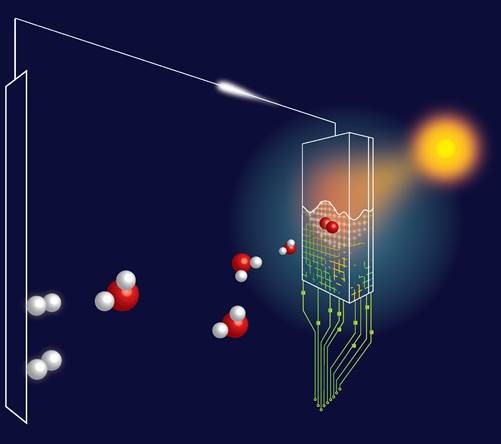DIFFER and Eindhoven University of Technology will jointly receive 700,000 euros to expand research on water-splitting and alternative renewable energy sources. This was announced by NWO. The researchers aim to take live measurements during water-splitting experiments and combine those with modeling.
The world is eagerly looking for renewable energy sources. Sun and wind are good alternatives, but when it is dark or calm, you need to turn to other sources. Researchers at DIFFER and Eindhoven University of Technology are therefore working on splitting water into oxygen and hydrogen. The idea is that you split water when there is a surplus of energy, for instance at times when the sun shines abundantly or when it is windy. The hydrogen produced in the water-splitting can be stored in terminals and batteries for later use.
However, splitting water into oxygen and hydrogen takes a lot of energy. Therefore, scientists are looking for catalysts that ease the splitting of water. In recent years, dozens of potential materials have been proposed to serve as catalysts. The problem so far is that these materials work well in theory but falter in practice.
"Sometimes it is due to the material, sometimes to the structure, sometimes to the surface," says project leader Anja Bieberle-Hütter from DIFFER. "But often we don't know. So there is a great potential to improve catalysts. "
Measuring during splitting
DIFFER and TU/e researchers argue that it is about time that measurements are made during water splitting and that these experiments are linked to models.
"By taking measurements under operando conditions, we get data with which we can make better, validated models," Bieberle-Hütter explains. "And because of the modeling, we understand our experiments better. So it's a win-win situation."
The researchers expect to be able to screen promising materials more efficiently and thereby identify more rapidly suitable catalysts to help split water.
The €700,000 is intended to hire two Ph.D. students from different disciplines. One Ph.D. student will join TU/e's electrical engineering department under the supervision of Siep Weiland. Another Ph.D. student will be stationed at Solar Fuels at DIFFER under the supervision of Anja Bieberle. "It is quite special that we have two Ph.D. students from such different fields working together on one project. This set-up is bound to lead to new catalysts," says Bieberle-Hütter.
Text continues after image.

M-grant
The money for the water-splitting project comes from an M-grant from the NWO's Sciences Domain. M-grants are intended for curiosity-driven, fundamental research of high quality and/or scientific urgency. The grant allows researchers to work out creative and risky ideas that can form the basis for the research themes of the future. A total of 72 applications were submitted. 19 applications were granted (26%).
Original Dutch text
Go to the News page.